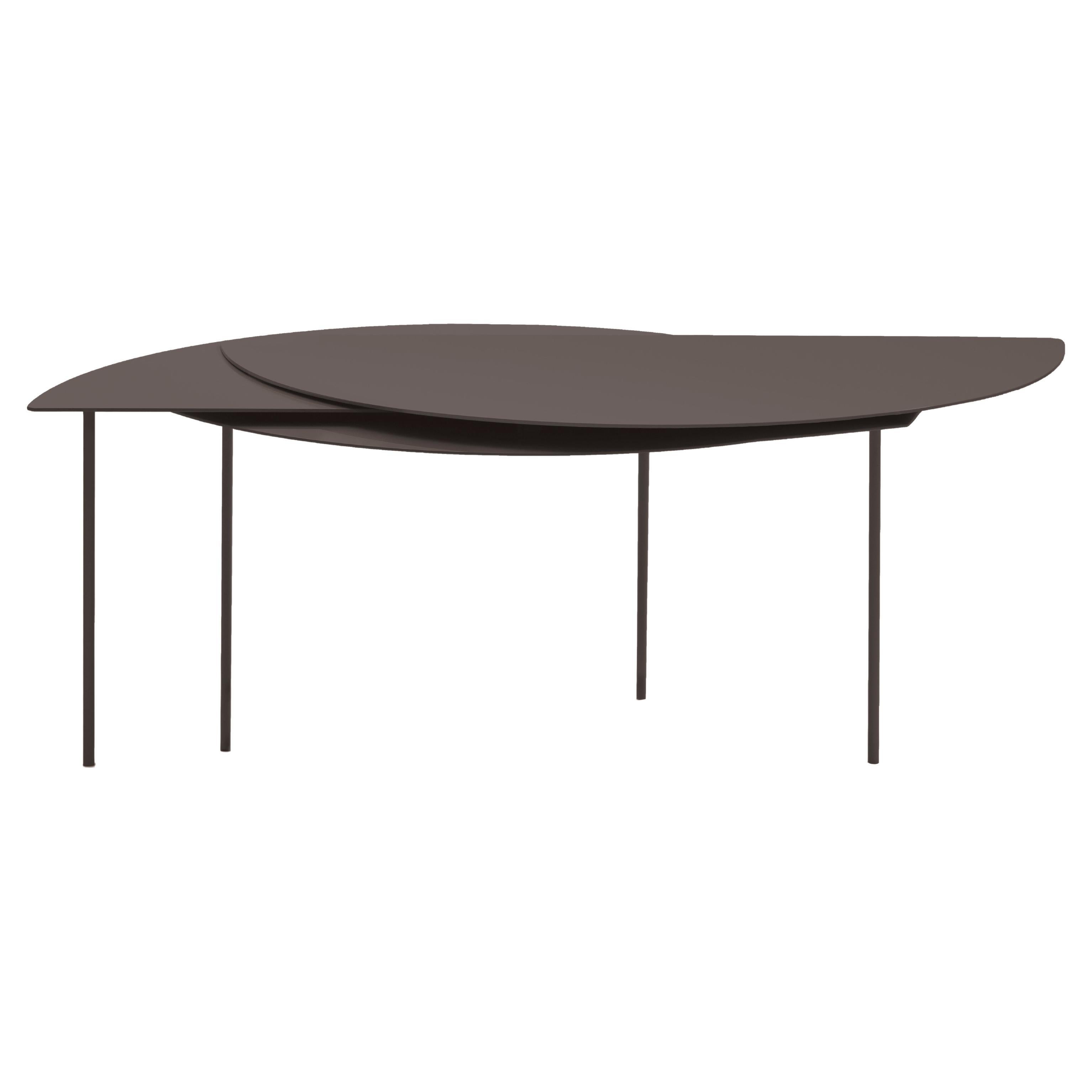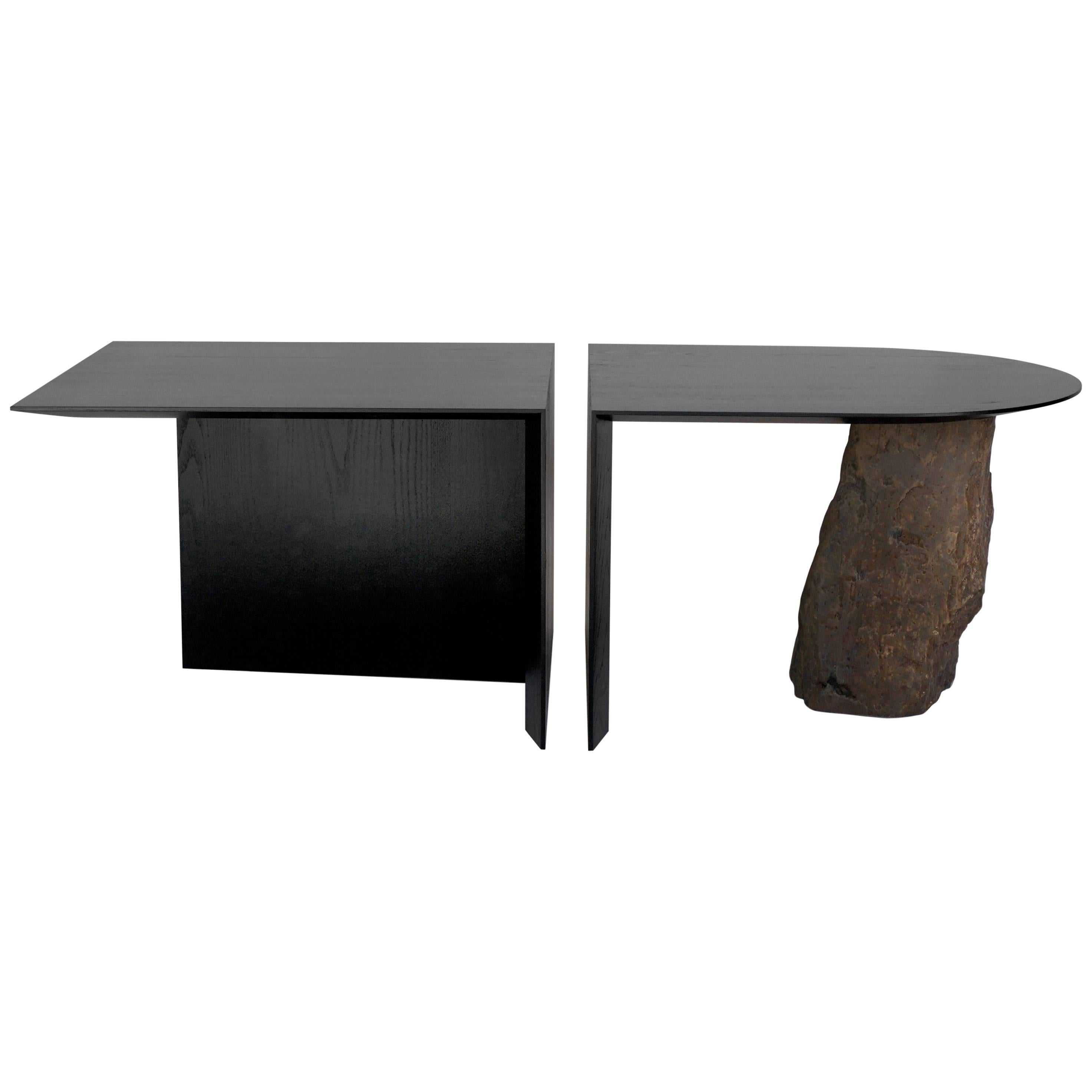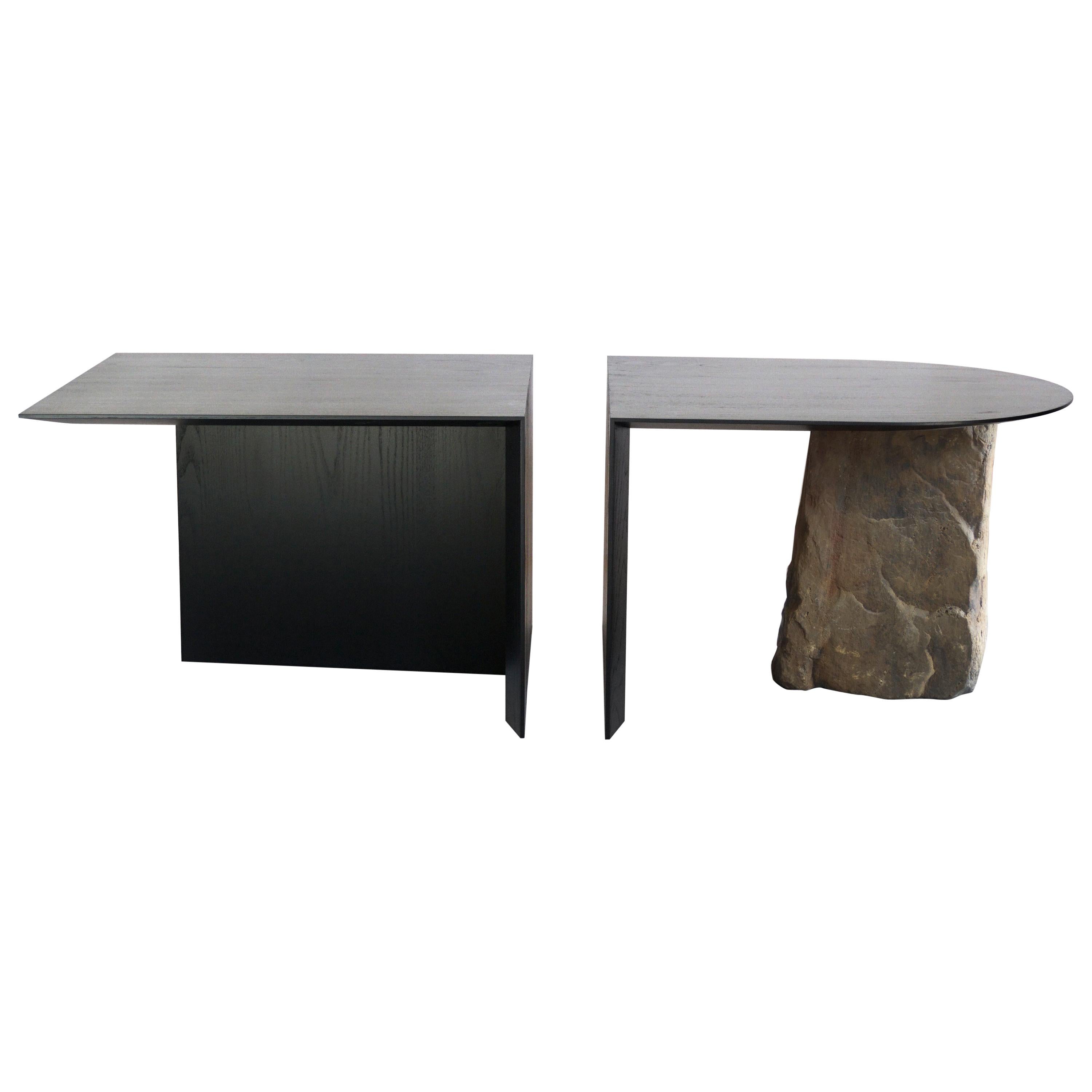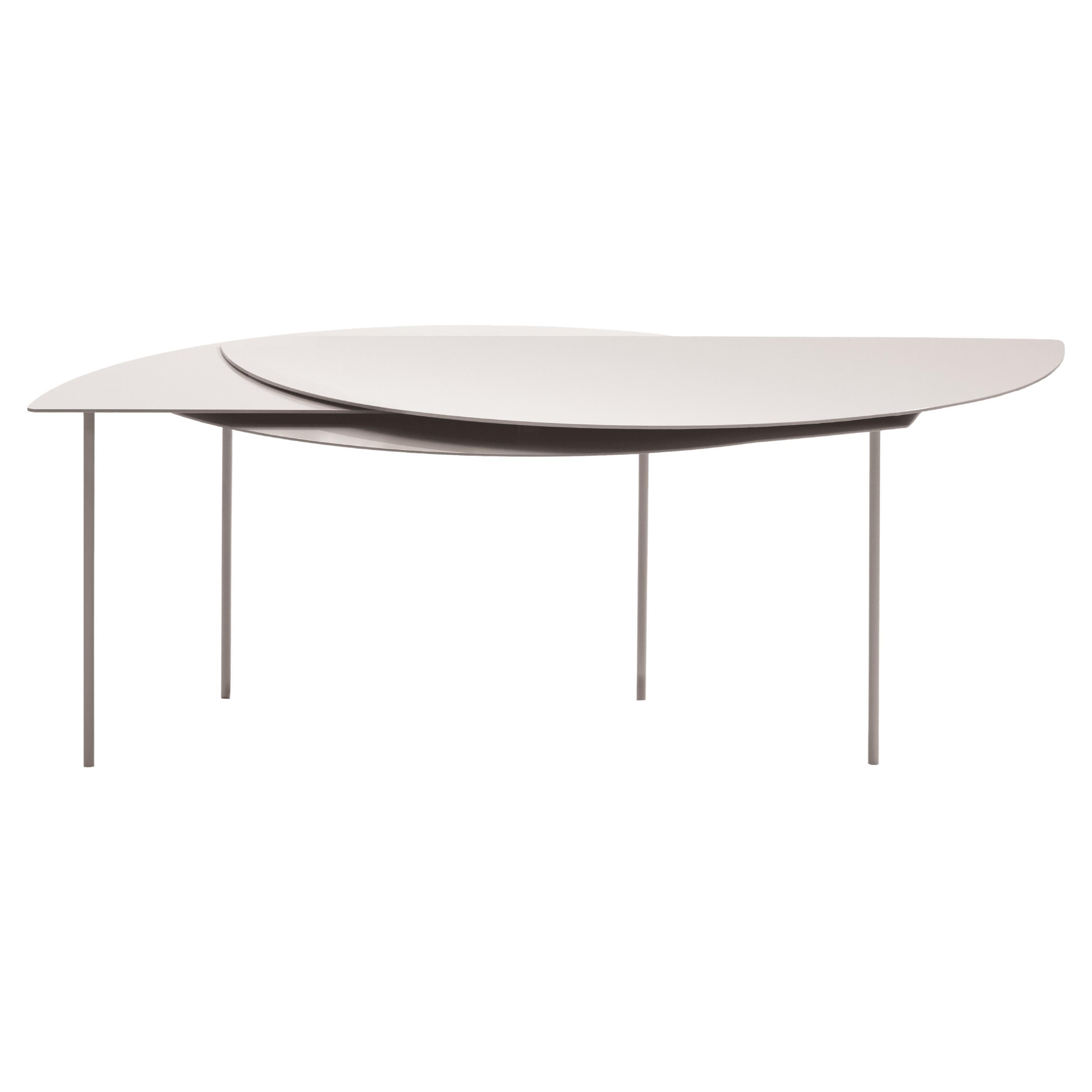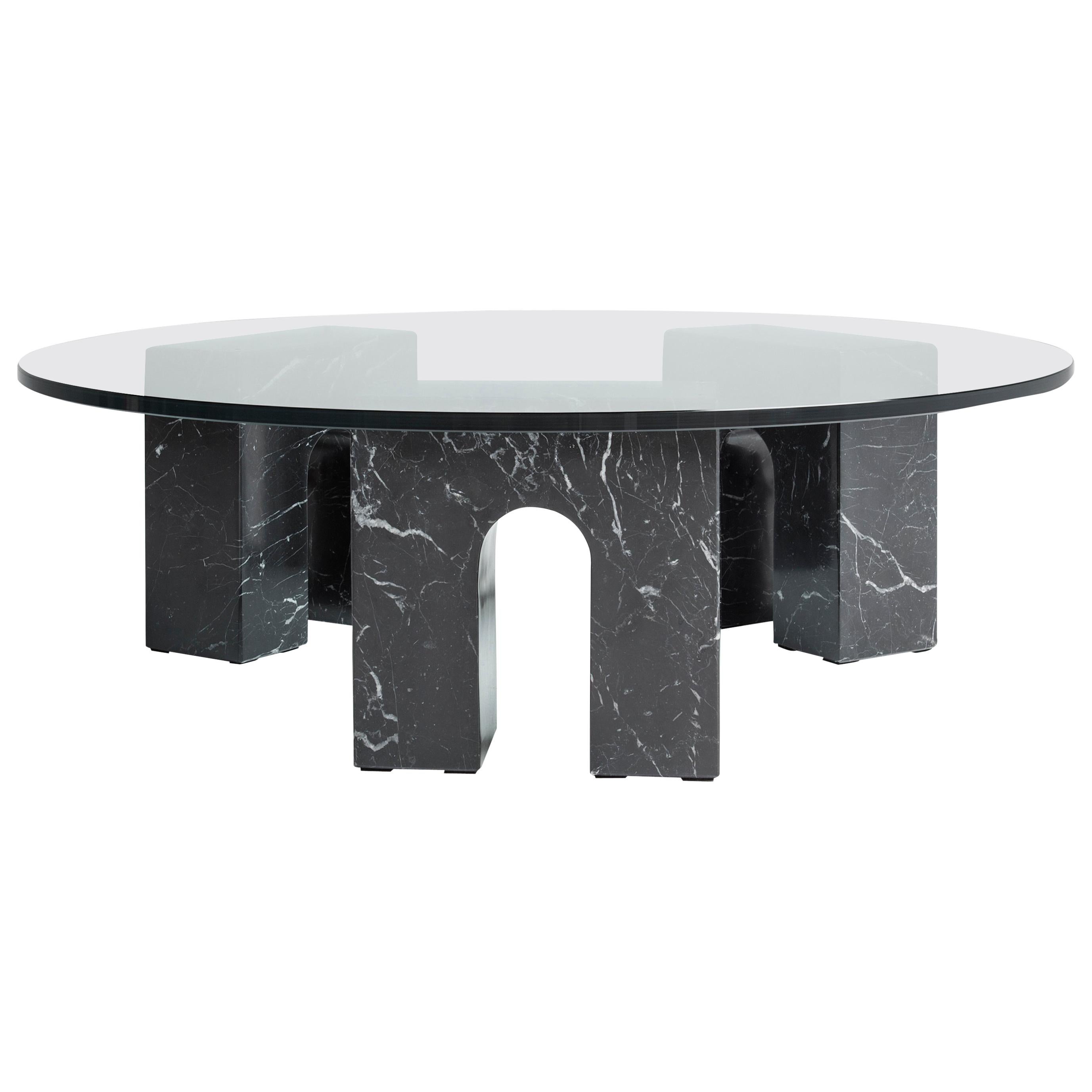Items Similar to Black Skull Marble Table by John Bizas limited Edition 1/8
Want more images or videos?
Request additional images or videos from the seller
1 of 6
Black Skull Marble Table by John Bizas limited Edition 1/8
About the Item
The black Skull table is a limited edition of 8, designed and produced in Italy by the artist John Bizas.
Its design following some of the rococo style principles and 180 degrees against some others has its own particular character between classic and modern.
Made from solid pieces of hand-hewn Belgian Black Marble, this impressive piece features Rococo style legs with a black marble skull in each corner and is topped with dark bevel-edged glass.
It’s designed to be demountable and like this can be transported and installed just by one person.
John Bizas was born on Chios island/Greece in 1980. From early age he was interested in fine arts and soon got involved in doing sculpture. The material he prefers to use is mainly marble, which he works in a particular way. His passion for marble is what made him move to Italy in 2008 where he still runs one of his studios in Pietrasanta. Beside this he has studios in Chios/Greece, Washington DC/USA and Moscow/Russia. In his works the classic materials meets the contemporary art. The artist like to use the empty space as material in his work. Like this he let the light of the ambient and the glance of the viewer to penetrate the form of the sculpture. His concept... the problems of our world (environmental disasters, war, animal abuse etc). Note that Bizas uses sharks as a central theme of his sculptures. Marble is his medium of choice. The fish is not the actual subject. His work is an analogy of humanity.
Artist's statement:
My art is the language I use to speak out about humanity’s dark side. My work is my response to what we have done to the planet and all the everyday cruelties we see around us such as war, invasions in the name of peace or religion, or environmental disasters. Many times we don’t see the impact of our negative actions. My work invites the viewer to attend to what we often overlook – both the problems we have created and how easily we could change the world for the better.
The media I prefer to use is the marble. I like to use this classic material to create contemporary art. Oftenly I mix them with other contemporary materials or objects.
- Dimensions:Height: 22.05 in (56 cm)Width: 40.95 in (104 cm)Depth: 40.95 in (104 cm)
- Style:Rococo (In the Style Of)
- Materials and Techniques:
- Place of Origin:
- Period:
- Date of Manufacture:2011
- Production Type:New & Custom(Limited Edition)
- Estimated Production Time:Available Now
- Condition:
- Seller Location:Paris, FR
- Reference Number:1stDibs: LU4817227549762
About the Seller
5.0
Vetted Seller
These experienced sellers undergo a comprehensive evaluation by our team of in-house experts.
Established in 2017
1stDibs seller since 2019
54 sales on 1stDibs
Typical response time: 17 hours
- ShippingRetrieving quote...Ships From: Paris, France
- Return PolicyThis item cannot be returned.
More From This SellerView All
- French Artist Charles Lapicque Tapestry Limited Edition 1/2 "Pelops", 1964By Charles LapicqueLocated in Paris, FranceExceptional limited edition 1/2 tapestry "Pelops" with certificate from a private collection, 1964. Ateliers Pinton brothers in Felletin, under the supervision of Pierre Baudouin 2ex + 1EA Editor Aram Iynedjian. The tapestry will be sold with its certificate of authenticity from the gallery. From the 15th century, the name of Pinton was associated with the Aubusson tapestry. Since then, over the generations, the Pinton family has largely contributed to the development of this fabulous cultural heritage until the creation in the 19th century, of the Felletin factory, in the department of Creuse. Even today, in these workshops, the craftsmen execute the same correct gestures with the same attention to detail and thus extend the chain of the history of the tapestry of tradition but also contemporary. The hand of specialists, the eye of designers and dyers and the taste of the most demanding clientele find their meaning in the fabric of the carpets. The excellence of French know-how, a living heritage society and custodian of Aubusson's cultural heritage, has always collaborated with great artists. The works of Charles Le Brun, Charles Lapicque, Pablo Picasso, Jean-Michel Othoniel, and many other big names in the world of painting, architecture, design, fell into the looms and know-how ancestral of this unique Creuse creator. Editor Aram Iynedjian Aram Iynedjian, Lausanne gallery owner and editor of tapestries from Braque, Estève and Lapicque, the latter meets Pierre Baudouin, the most famous of the cardboard painters of the time. The one who translated the works of Le Corbusier, Calder or Picasso into tapestry then collaborates with Charles Lapicque and they will develop a work of great richness. Lapicque came to realize these two summits which are "Pélops" and "Diane et Actéon". I realize that you should never try to describe a work of art Let’s look at it. Let us admire the science of composition, linear purity, technical perfection, the beauty of color, the truth of the drama. Let us see, if we can, the implacable presence of genius. "We will now understand that after having based a painting on the love of tapestry, it was relatively easy, and very tempting, to build a tapestry faithful to my painting," explained the artist in the exhibition catalog. of the Galerie Verrière in 1970. It was not until 1961 that he began to produce cardboards both for the tapestry of the Lisse in Aubusson, but also at the Mobilier National, with the help of Pierre Baudouin Charles Lapicque (1898-1988) Born in 1898 in Theizé (Rhône) in a family practicing both the arts and the sciences, Charles Lapicque is no exception to the rule: gifted for music and drawing, he graduated from the École Centrale in 1921, works as engineer until 1928 before integrating in 1931 a laboratory at the Faculty of Sciences of Paris, where he carried out research on the perception of colors, crowned by the title of Doctor of Physical Sciences in 1938. He thus studies the reactions of the eye in front of an intense light source, at the origin of the formation of starry images which he will use in his works, and defines a theory of the staggering of colors in space which overturns the rules of the Renaissance: "I had shown that the Classic rule, that of Vinci, advocating placing the blues in the distance, the reds, oranges and yellows in the foreground, is a nonsense; it makes more sense, more favorable to do the opposite. "(In Red and blue in the arts, 1936) It was around 1920 that Charles Lapicque began to paint in Brittany where he spent every summer since his childhood, first on the motif and then in a workshop that his stepfather Jean Perrin, Nobel Prize in Physics, had him build in 1927 ; he then definitively adopted the work of memory, in accordance with the art of music which he deeply loved and the Bergsonian philosophy of knowledge: "It is up to us to give reality an appearance that it has no itself, a form, a figure (...). " His youthful production immediately reveals a great originality, oscillating between figuration and abstraction which sometimes intertwine: alongside synthetic paintings by their simplified drawing and their flat colors, he designs an Homage to Palestrina (1925), composed of a grid derived from Cubism, entirely abstract, relayed by a Christ with Thorns (1939), according to a principle that he will develop after 1939, in line with his optical discoveries. In fact, during the war years, an almost abstract period began, that of the tight blue framework, applied to backgrounds ranging from yellow to red and revealing a more or less identifiable world (Jeanne d'Arc crossing the Loire, 1940; Rencontres series, 1940-1945). Exhibited in 1929 by the gallery owner Jeanne Bucher, Lapicque abandoned his scientific career in 1943 to devote himself entirely to painting. He continued his work which resulted in 1946-1953 in white-frame structures; their much softer lines lead him to the system of either black or white interlacing which encloses areas of pure color, most often in solid color. With The Battle of Waterloo in 1949, Lapicque still uses optics - zooming in on a given area - to depict spaces with multiple perspectives and decomposed times. This new interest in the liveliness of color developed in the following period, which can be described as flamboyant or Baroque (1954-1963): illustrated in particular by the series of Breton lagoons and twilight or nocturnal views of Venice in the light. Stars, which the artist himself describes as “daring sweets”, it begins with the Raoul Dufy Prize of the Venice Biennale, awarded in 1953 to the artist who took the opportunity to give free rein to his passion for the Serenissima until July 1956. Another point in common with his elder brother is the expression of movement. Begun in 1949 in The Battle of Waterloo then in 1952 with Dimanche aux regates, it became an obsession from 1964, in the exploration of new themes, such as the different shots of tennis players captured on the fly (1965), the mythological scenes and sea storms. These dizzying years precede the artist's last period: as he comes of age, he discovers serenity, revealed by a painting now with acrylic paint, much more peaceful from 1974, which even borders on a childish naivety at the end. of his life. All of his work includes an astonishing diversity of themes, also nourished by his travels (Rome in 1957, Greece in 1964, Holland in 1974 ...), with a predilection for the sea, rocks, sailboats, music, tennis, horses, wild beasts, but also for history and mythology, as evidenced by knights, kings and ancient gods. It also deploys, in total creative freedom, a wide variety of styles and orientations. Having been one of the pioneers of non-figurative art, thus paving the way for artists like Manessier, Bazaine, Vieira da Silva, De Staël, etc. Owners of the new non-figurative Paris School of the Postwar period, Charles Lapicque then returned to figuration, in a "new interpretation" of appearance, even if he continued to rub shoulders with abstraction at times. "Drawing runs after color and color after drawing. " Heir to the Fauves, Charles Lapicque plays like them on pure colors, whose dissonances, associated with a totally free design and an overloaded composition in a multiple space, make him a precursor of the New Figuration in all its forms: the Narrative Figuration born in France in the early 1960s, represented in particular by Gérard Fromanger, Erró, Bernard Rancillac and Gérard Guyomard; Free Figuration born in the early 1980s, marked by Robert Combas, Hervé and Richard Di Rosa, Louis Jammes and François Boisrond, and which, in turn, influenced the American Bad Painting of a Jean-Michel Basquiat or a Keith Haring, deliberately neglected and Expressionist; Lapicque's “Classic subjects” were able to feed Cultivated Painting, which also appeared in the early 1980s with Jean-Michel Alberola, Patrice Giorda and Gérard Garouste...Category
Mid-20th Century European Tapestries
MaterialsWool
- Moroccan Orientalist Moorish Round Polished Brass Side, circa 1920Located in Paris, FrancePedestal table or side table with fixed brass top and elegant wooden base in a stylized form of gazelle legs. The English table from the 1920s in a golden brass is chiseled and hammered by hand with calligraphy cartridges, stars, leaves and beautiful elements will bring a sophisticated touch in your moorish - Spanish decor or Moroccan style interiors. Pierre Berger...Category
Early 20th Century British Art Nouveau Side Tables
MaterialsBrass
- Vintage Monix Floor Lamp 3 Orientable Spots, Édition 1960By Edition MonixLocated in Paris, FranceRare Monix floor lamp 3 adjustable and orientable spots on a metal barrel nickeled and lacquered black, foot circular base. Each spot has its own switch to be adjusted and can be use...Category
Antique Mid-19th Century French Floor Lamps
MaterialsMetal, Nickel
- Danish Rosewood Set Nesting Tables by Kai Kristiansen, 1960By Kai KristiansenLocated in Paris, FranceVintage elegant set of 3 nesting tables in rosewood designed by Kai Kristiansen from 1960 ( 1 ) L 57,5 x P 37,5 x H 45,5 ( 2 ) L 48 x P 34,5 x H 43,5 ( 3 ) L 38,5 x P 31 x H 41.Category
Mid-20th Century Danish Nesting Tables and Stacking Tables
MaterialsRosewood
- Sculptural Marble Lamp Space Age Shape, circa 1970sLocated in Paris, FranceSculptural lamp in Carrara marble with a conical shape, illuminated from the inside, it lets a light diffused that reveals the veins of the Carrara marble. Three plexiglass discs at ...Category
Late 20th Century Italian Floor Lamps
MaterialsCarrara Marble
- Wall Hat- Coat Rack with Mirror in Black and Yellow by Mathieu Matégot, 1950sBy Mathieu MatégotLocated in Paris, FranceVery rare and big French metal wall coat rack by Mathieu Matégot with a mirror. Lovely colorful coat rack by Mathieu Matégot in lacquered and perfor...Category
Mid-20th Century French Coat Racks and Stands
MaterialsMetal
You May Also Like
- Alhena Extendable Side Table Minimal Contemporary Limited Edition Black SteelBy JacobsroomLocated in Roma, ITAlhena is a limited edition extendable coffee table in black metal, that is part of the Celestine collection designed by Jacobsroom Studio in Rome. The coffee table's minimal shape ...Category
2010s Italian Modern Coffee and Cocktail Tables
MaterialsMetal, Steel
- Missisquoi 01 Coffee Table (Edition 9 of 13) by Simon JohnsBy Simon JohnsLocated in East-Bolton, QuebecMissisquoi 01 is a numbered and asymmetrical two part coffee or cocktail table, with a space that divides it as the river divides the Missisquoi Valley. The black ashwood was felled, milled and dried near the studio, and the stone is from the river's banks. The stone and plank that support the two parts form a continuous axis end to end, through the divide. The beauty of the Brutalist natural stone contrasts and converses with the delicate craftsmanship of the wood plateau...Category
2010s Canadian Post-Modern Coffee and Cocktail Tables
MaterialsStone
- Missisquoi 01 Coffee Table (Edition 4 of 13) by Simon JohnsBy Simon JohnsLocated in East-Bolton, QuebecMissisquoi 01 is a numbered and asymmetrical two part coffee or cocktail table, with a space that divides it as the river divides the Missisquoi Valley. The black ashwood was felled, milled and dried near the studio, and the stone is from the river's banks. The stone and plank that support the two parts form a continuous axis end to end, through the divide. The beauty of the Brutalist natural stone contrasts and converses with the delicate craftsmanship of the wood plateau...Category
2010s Canadian Modern Coffee and Cocktail Tables
MaterialsStone
- Missisquoi 01 Coffee Table (Edition 5 of 13) by Simon JohnsBy Simon JohnsLocated in East-Bolton, QuebecMissisquoi 01 is a numbered and asymmetrical two part coffee or cocktail table, with a space that divides it as the river divides the Missisquoi Valley. The black ashwood was felled, milled and dried near the studio, and the stone is from the river's banks. The stone and plank that support the two parts form a continuous axis end to end, through the divide. The beauty of the Brutalist natural stone contrasts and converses with the delicate craftsmanship of the wood plateau...Category
2010s Canadian Post-Modern Coffee and Cocktail Tables
MaterialsStone
- Alhena Extendable Side Table Minimal Contemporary Limited Edition White MetalBy JacobsroomLocated in Roma, ITAlhena is a limited edition extendable coffee table in white metal, that is part of the Celestine collection designed by Jacobsroom Studio in Rome. The coffee table's abstract shape...Category
2010s Italian Modern Coffee and Cocktail Tables
MaterialsMetal, Steel
- “Arch Table” Black Marquina Marble and Glass Minimalist Coffee TableBy Josep Vila CapdevilaLocated in Terrassa, CataloniaThe Arch Table is a minimalist style coffee table consisting of three treated Marquina marble bases and a round shaped tempered glass top, all of them assembled in a logical and harm...Category
21st Century and Contemporary Spanish Minimalist Coffee and Cocktail Tables
MaterialsMarble
Recently Viewed
View AllMore Ways To Browse
Solid Black Marble Table
Furniture In Washington Dc
Washington Dc Furniture
Couch Side Tables Contemporary
Glass Sofa Side Table
Italian Sofa With Side Tables
Space Age Marble
Glass Table Marble Legs
Contemporary Limited Edition Marble
Marble Top Belgian Table
Italian Marble Sofa Table
Impressive Rococo
Sculptured Sofa Table
Rococo Italian Marble Furniture
Table With Animal Leg
Italian Marble Table Living Sofa Table
Animal Leg Table
Table Marble Leg Glass Top
